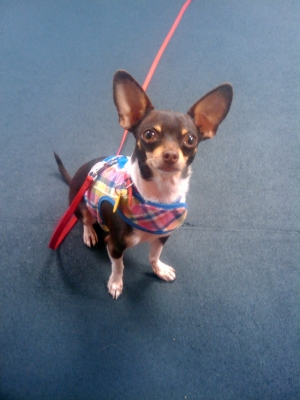Taking A Training Class: Headstart

Congrats on signing up for a training class with your dog!! (and if you haven't - why not??)
Below is a list of tips I have compiled for a training class student. I am sharing these to help make learning fun for both you and your dog - and class for teachers a little more sane.
1. Bring a hungry dog. If your class is at 6pm, skip dinner. A good rule of thumb is to not feed your dog for at least 4 hours prior to class. A hungry dog is a MOTIVATED dog, in most cases. This is probably the most important tip of them all.
2. Bring soft treats of different varieties - already cut up in appropriate size. Do not bring milkbones. Combine some of your dog's normal meal kibble with delicious treats that are pea-sized. The softer the treat the quicker you can train because there is little to no chewing involved. Some favorites of mine are chopped up chicken breast, dog food roll cut up small(not the refrigerated kind), cheese, and any other leftover meat that is safe for dogs. I have even heard of using cooked kidney beans for training treats. Do not assume that because your dog eats whatever it is at home he will necessarily have interest in it amidst a distracting, exciting environment.
3. Bring a stuffed Kong, Bullystick or other type of long-term consumable. This will keep your dog occupied during down time and demonstrations. You can fill this with a myriad of things, but make it sticky so it is harder to get out and STINKY to keep your dog's attention. Peanut Butter is an obvious choice, but I am sure you can come up with some other good ideas (tuna and cream cheese?). Freeze it, whatever you do, for an even longer term project. Share it with your dog during class by placing it under your foot to share possession and keep it from flying around the room.
4. Ditch the flexi-lead. They are dangerous. Dogs can get tangled around each other quickly and easily. The stop feature on Flexi-leads has, can, and will break - you never know when; hopefully it won't be in class. Other reasons to not use a flexi-lead include risk of amputation (it is written all over the package) and erosion your loose-leash walking practice. Instead, bring a 4-5' standard leash - preferrably leather for traction, but nylon will always suffice.
5. If your dog isn't super-foodie, as we say, bring something that does motivate him. If it is a tennis ball, bring that. If it is a favorite stuffed toy, bring that. Squeaky toys are okay. but if your training class has more than one squeaky toy fanatic, which there is bound to be, you might have an issue on your hands.
6. If you have a harness for your dog, use it.
7. Don't show up more than 5 minutes prior to class unless instructed to do so. Humans are great at waiting for things, dogs are not.
8. Tire your dog out before class. Spend some extra time playing fetch or tug so his energy tank is emptied more.
9. Wear a bait bag. They make ones that don't look really terrible now - I swear. Even if you end up wearing a fannypack, we won't tell. Your secret is safe with us. My favorite bait bag is the QuickDraw, but there are other types out there in all colors and patterns. You will thank me later.
10. Don't greet other dogs in the class prior or during to it (without permission from the instructor)! In some adult classes not all dogs are dog-friendly - that is why they are on-leash classes.
Enjoy class and Happy Training!!
(I am sure there are more tips from the other trainers on this site that I didn't think of - please add them below in the comments!!)




